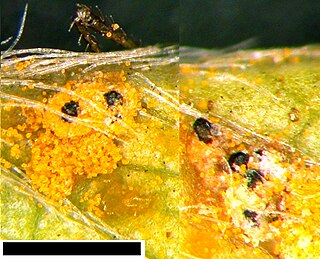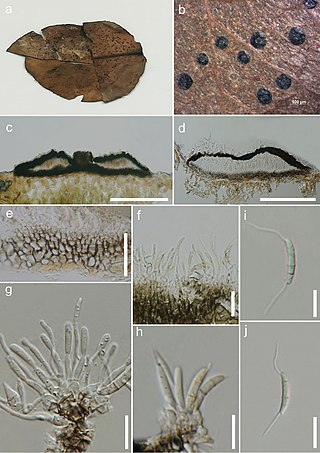
The Nectriaceae comprise a family of fungi in the order Hypocreales. It was circumscribed by brothers Charles and Louis René Tulasne in 1865. In 2020, an Outline of fungi was produced and listed 70 genera and about 1,336 species.
The fungal genus Truncatella in the family Sporocadaceae, and in the Amphisphaeriales order, includes plant pathogens such as Truncatella laurocerasi.

The Phaeosphaeriaceae are a family of fungi in the order Pleosporales. Species in the family have a cosmopolitan distribution, and are generally nectrotrophic or saprobic on a wide range of plants.
Teratosphaeria is a genus of fungi in the family Teratosphaeriaceae; according to the 2007 Outline of Ascomycota, it was placed in the Phaeosphaeriaceae, but the placement within this family was uncertain. It was confirmed in 2020, within Teratosphaeriaceae by Wijayawardene et al. 2020.
Broomella is a genus of fungi in the family Sporocadaceae.

Lepteutypa is a genus of plant pathogens in the family Amphisphaeriaceae. First described by the Austrian mycologist Franz Petrak in 1923, the genus contains 10 species according to a 2008 estimate. It was increased to 15 in 2020.
Keissleriella is a genus of fungi, that was originally placed in the Massarinaceae family, before being placed in the Lentitheciaceae family.

Pestalotiopsis is a genus of ascomycete fungi in the Sporocadaceae family.

Monochaetia is a genus of fungi in the family Sporocadaceae. Species in the genus are typically plant parasites and saprobes, and cause leaf spot diseases on various hosts.
Seimatosporium is a fungus genus within the family Sporocadaceae.
Microsphaeropsis is a genus of fungi belonging to the family Didymosphaeriaceae.

Seiridium cardinale is a species of fungus within the genus of Seiridium, in the Sporocadaceae family.

The Amphisphaeriales are an order of fungi within the class Sordariomycetes and subclass Xylariomycetidae.

The Sporocadaceae are a family of fungi, that was formerly in the order Xylariales. It was placed in the Amphisphaeriales order in 2020.

Sporocadus is a genus of plant pathogens in the family Sporocadaceae.

Discosia is a genus of plant pathogens in the family Sporocadaceae.
Sarcostroma is a genus of fungi in the family Sporocadaceae. Most species of this genus are saprobes, endophytes or pathogens on leaves.

Neocamarosporium is a genus of ascomycete fungi, as accepted by Wijayawardene et al. 2020. The species are typically halotolerant, being commonly found in saline environments like in saline water, hypersaline soils and especially in association with halophytes.










